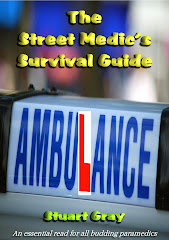Day shift: Five calls; two assisted-only, three by ambulance.
Stats: 1 MI; 1 eTOH fit; 1 Dizzy person; 1 eTOH; 1 ?CVA
An unusual case to start the day. A 57 year-old man crashed his van into the barriers at the side of a busy road after having what everyone thought was an epileptic fit. The crew was on scene and I arrived as they took him into the ambulance. He certainly looked as if he’d had some kind of fit and there was evidence of him having lost bladder control in the vehicle but his demeanour shouted a lot more about him and his ECG appeared to show that he was having an MI but our ECG’s can be unreliable at times and when he got to hospital they discovered that he was in unstable VT.
It turns out he’d gone into VF whilst driving and lost consciousness as he began to arrest – this caused him to roll into the barrier as his vehicle crossed the road under no control whatsoever. The collision wasn’t enough to hurt him badly but it did create a significant thump to his chest and this acted like a defibrillator, bringing him out of VF and into VT. His life was probably saved by it and he most likely had a seizure as a result of oxygen deprivation.
He lay on the bed in Resus telling everyone that he felt fine, while his ECG did strange things and the staff put defib pads on him. I probably won’t see that combination of events for the rest of my career.
A 67 year-old alcoholic had a fit at a train station (in fact, according to witnesses he had three). The crew was on scene with me and another turned up for good measure but he was stable and didn’t fit again as far as I’m aware.
The new drugs for Parkinson’s work well to control the symptoms and my next patient, afflicted with this condition, suffered a dizzy spell after walking around all morning with his wife. The man looked perfectly fine as he sat on a bus and if he hadn’t told me he had Parkinson’s I wouldn’t have known. After a long chat, in which I learned that he used to be an architect and that he dabbled in digital photography and knew more about computers than his grand-children, the crew arrived to take him on board for further checks before letting him and his wife continue their onward journey home.
Another alcoholic who was said to be fitting wasn’t in fact. He just lay on the pavement, worrying passers-by. He still had the pyjama bottoms on from his last trip to hospital and he wasn’t interested in another visit, so I helped him up and he staggered away to a better place for sleeping.
An off-duty nurse helped me with my last patient, a 40 year-old man who was suffering a ?CVA at a train station. Screens had been erected around him, which is always useful and something we can’t carry around because of the lack of space in our vehicles but they served me well and the privacy and dignity of the patient was preserved as people rushed around catching and leaving trains.
I had enough time to put a line in, just in case, before the ambulance arrived to take the confused and agitated man away.
Be safe.
Subscribe to:
Post Comments (Atom)















2 comments:
"it did create a significant thump to his chest"
Significant indeed if this rather informal way of administering a 'Precordial thump' saved his life!
re: the "significant thump" incident. When I was doing my OFA 3s a while back (OFA being Occupational First Aid - highest level, and a prereq for my EMT course next month), we were running through weird scenarios for fun during a practice day. Basically, going through cases that had actually happened to our instructor.
Anyways, mine basically involved a guy that had been having a MI, hit an exposed wire, and was shocked. But the shock got his heart going again. The instructor said it was "the damnedest thing" he'd ever seen.
(P.S. I love this blog. It's thoroughly addicting to read).
Post a Comment